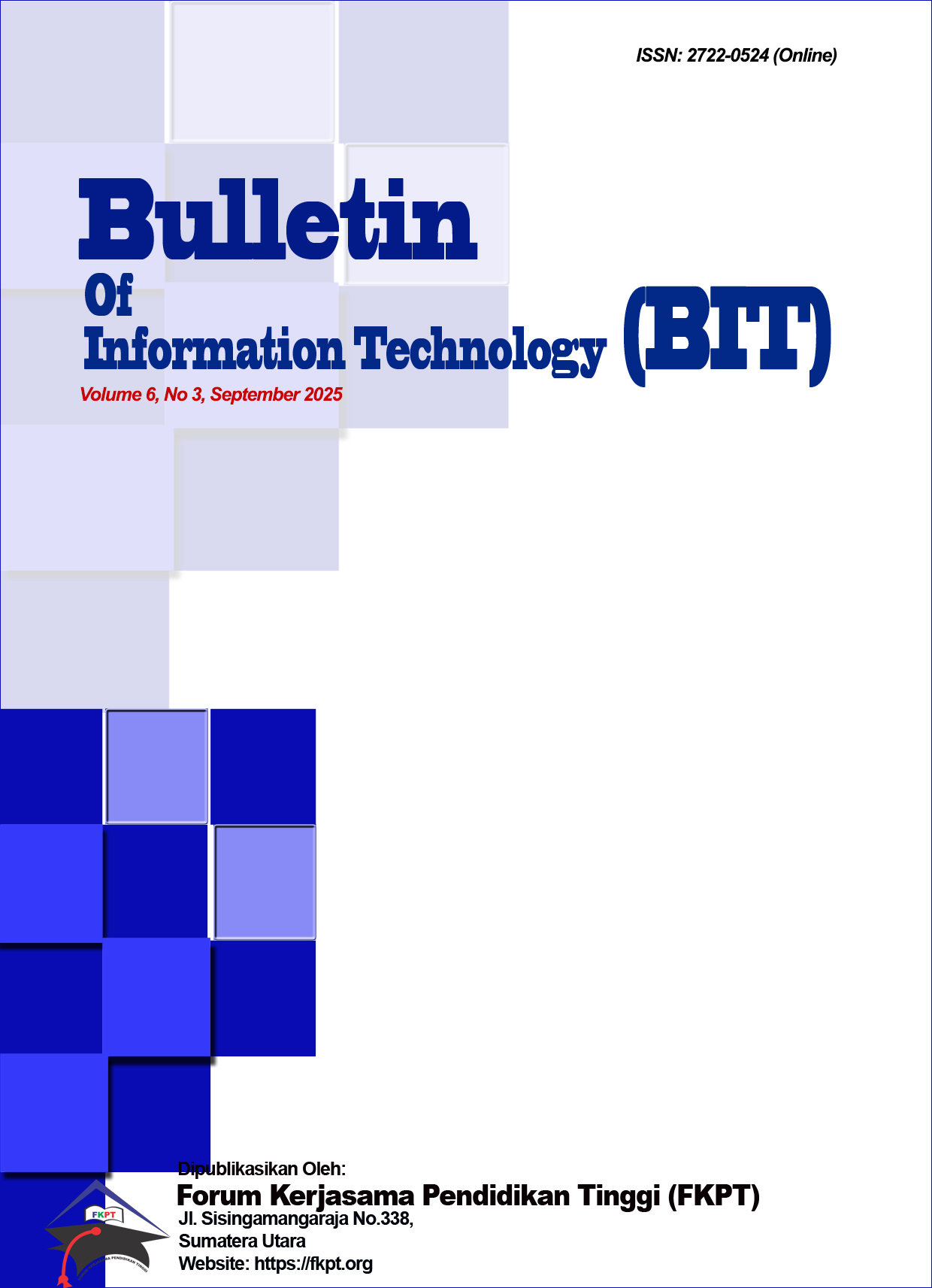Klasifikasi Genre Musik Menggunakan Machine Learning
Abstract
This study examines the implementation of music genre classification using Machine Learning to develop an accurate and efficient music recommendation application. The main problem addressed is the automatic identification of music genres to improve recommendation personalization. The method used involves applying Machine Learning algorithms to a music dataset. The objective of this research is to build a system capable of automatically classifying music genres and serving as a foundation for a smarter recommendation system. Preliminary results indicate that Machine Learning is effective in music grouping, which will contribute to increased recommendation accuracy. This research is expected to make a significant contribution to the development of intelligent music applications.
References
D. Sukietra, “Aplikasi Rekomendasi Musik Berdasarkan Klasifikasi Genre Menggunakan Convolutional Neural Networks,” KALBISIANA J. Sains, Bisnis dan Teknol., vol. 10, no. 1, pp. 91–98, 2024, doi: 10.53008/kalbisiana.v10i1.3527.
R. Indriati and S. B. Persada, “Information retrieval pencarian informasi jenis Musik,” Pros. Semin. Nas. Inov. Teknol., pp. 305–310, 2018, [Online]. Available: https://proceeding.unpkediri.ac.id/index.php/inotek/article/view/500
D. Nuriska, B. Irawan, A. Bahtiar, and A. Rinaldi Dikananda, “Klasterisasi Data Lagu Terpopuler Spotify 2023 Berdasarkan Suasana Hati Menggunakan Algoritma K-Means,” JATI (Jurnal Mhs. Tek. Inform., vol. 7, no. 6, pp. 3843–3850, 2024, doi: 10.36040/jati.v7i6.8232.
C. R. Wairata, E. R. Swedia, and M. Cahyanti, “Pengklasifikasian Genre Musik Indonesia Menggunakan Convolutional Neural Network,” Sebatik, vol. 25, no. 1, pp. 255–261, 2021, doi: 10.46984/sebatik.v25i1.1286.
S. Navisa, Luqman Hakim, and Aulia Nabilah, “Komparasi Algoritma Klasifikasi Genre Musik pada Spotify Menggunakan CRISP-DM,” J. Sist. Cerdas, vol. 4, no. 2, pp. 114–125, 2021, doi: 10.37396/jsc.v4i2.162.
I. G. Harsemadi, “Perbandingan Kinerja Algoritma K-NN dan SVM dalam Sistem Klasifikasi Genre Musik Gamelan Bali,” INFORMATICS Educ. Prof. J. Informatics, vol. 8, no. 1, p. 1, 2023, doi: 10.51211/itbi.v8i1.2417.
Y. V. Via, I. Y. Purbasari, and A. P. Pratama, “Analisa Algoritma Convolution Neural Network (Cnn) Pada Klasifikasi Genre Musik Berdasar Durasi Waktu,” Scan J. Teknol. Inf. dan Komun., vol. 17, no. 1, pp. 35–41, 2022, doi: 10.33005/scan.v17i1.3251.
S. LUTFIANI, T. H. Saragih, F. Abadi, M. R. Faisal, and D. Kartini, “Perbandingan Metode Extreme Gradient Boosting Dan Metode Decision Tree Untuk Klasifikasi Genre Musik,” J. Inform. Polinema, vol. 9, no. 4, pp. 373–382, 2023, doi: 10.33795/jip.v9i4.1319.
H. F. Putro, R. T. Vulandari, and W. L. Y. Saptomo, “Penerapan Metode Naive Bayes Untuk Klasifikasi Pelanggan,” J. Teknol. Inf. dan Komun., vol. 8, no. 2, 2020, doi: 10.30646/tikomsin.v8i2.500.
R. Kurniawan, P. B. Wintoro, Y. Mulyani, and M. Komarudin, “Implementasi Arsitektur Xception Pada Model Machine Learning Klasifikasi Sampah Anorganik,” J. Inform. dan Tek. Elektro Terap., vol. 11, no. 2, pp. 233–236, 2023, doi: 10.23960/jitet.v11i2.3034.
R. W. Putri, A. Ristyawan, and M. N. Muzaki, “Comparison Performance of K-NN and NBC Algorithm for Classification of Heart Disease,” JTECS J. Sist. Telekomun. Elektron. Sist. Kontrol Power Sist. dan Komput., vol. 2, no. 2, p. 143, 2022, doi: 10.32503/jtecs.v2i2.2708.
A. Tangkelayuk, “The Klasifikasi Kualitas Air Menggunakan Metode KNN, Naïve Bayes, dan Decision Tree,” JATISI (Jurnal Tek. Inform. dan Sist. Informasi), vol. 9, no. 2, pp. 1109–1119, 2022, doi: 10.35957/jatisi.v9i2.2048.
H. A. N. S. Habibi, A. Nugroho, and R. Firliana, “Perbandingan Algoritma Naïve Bayes Classifier Dan K-Nearest Neighbors Untuk Analisis Sentimen Covid-19 Di Twitter,” J. Ilm. Inform., vol. 11, no. 01, pp. 54–62, 2023, doi: 10.33884/jif.v11i01.7069.
Isman, Andani Ahmad, and Abdul Latief, “Perbandingan Metode KNN Dan LBPH Pada Klasifikasi Daun Herbal,” J. RESTI (Rekayasa Sist. dan Teknol. Informasi), vol. 5, no. 3, pp. 557–564, 2021, doi: 10.29207/resti.v5i3.3006.
G. P. Kawani, “Implementasi Naive Bayes,” J. Informatics, Inf. Syst. Softw. Eng. Appl., vol. 1, no. 2, pp. 73–81, 2019, doi: 10.20895/inista.v1i2.73.
I. Nurjanah, J. Karaman, I. Widaningrum, D. Mustikasari, and S. Sucipto, “Penggunaan Algoritma Naïve Bayes Untuk Menentukan Pemberian Kredit Pada Koperasi Desa,” Explorer (Hayward)., vol. 3, no. 2, pp. 77–87, 2023.
M. M. Mutoffar and A. Fadillah, “Klasifikasi Kualitas Air Sumur Menggunakan Algoritma Random Forest,” Naratif J. Nas. Riset, Apl. dan Tek. Inform., vol. 4, no. 2, pp. 138–146, 2022, doi: 10.53580/naratif.v4i2.160.
W. Apriliah, I. Kurniawan, M. Baydhowi, and T. Haryati, “Prediksi Kemungkinan Diabetes pada Tahap Awal Menggunakan Algoritma Klasifikasi Random Forest,” Sistemasi, vol. 10, no. 1, p. 163, 2021, doi: 10.32520/stmsi.v10i1.1129.
Andani, S. R., & Karim, A. (2025). Enhancing Lung Cancer Detection: Optimizing CNN Architectures through Hyperparameter Tuning. Jurnal RESTI (Rekayasa Sistem dan Teknologi Informasi), 9(4), 944-954.
Copyright (c) 2025 Garda Zidane Dhamara, Sucipto

This work is licensed under a Creative Commons Attribution 4.0 International License.
Authors who publish with this journal agree to the following terms:
- Authors retain copyright and grant the journal right of first publication with the work simultaneously licensed under Creative Commons Attribution 4.0 International License that allows others to share the work with an acknowledgment of the work's authorship and initial publication in this journal.
- Authors are able to enter into separate, additional contractual arrangements for the non-exclusive distribution of the journal's published version of the work (e.g., post it to an institutional repository or publish it in a book), with an acknowledgment of its initial publication in this journal.
- Authors are permitted and encouraged to post their work online (e.g., in institutional repositories or on their website) prior to and during the submission process, as it can lead to productive exchanges, as well as earlier and greater citation of published work (Refer to The Effect of Open Access).




.png)
.png)



